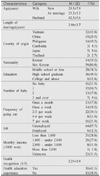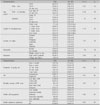Abstract
Purpose
The purpose of this study was to identify health promotion behavior and contraception in married immigrant women.
Method
Seventy-three immigrant women who were married with Korean men were recruited in October 2008. Data was collected by using questionnaires through a personal interview. The collected data was analyzed by descriptive statistics, Pearson's correlation, t-test, and ANOVA.
Result
The lowest scoring part among health promotion behaviors was exercise. Stress management, eating habits and personal relationships followed. Health promotion behaviors were influenced by the age at marriage, frequency of going out, and health education experiences. Only 35.6% of subjects used contraception. The popular contraceptive methods were IUD, condom, and coitus interruptus. Most subjects got information about contraception from family and friends. 18.1% of subjects had no source of information. The women's education level had a significant influence on their contraceptive knowledge.
Figures and Tables
References
1. Ahn Y.H. Health Status and Health Behavior of Immigrant Women Married to Koreans. J Korean Academy of Public Health Nursing. 2008. 22(1):18–26.
2. Cho O.S., Lee M.L. Experience of Married Women on Contraception. J Korean Academy of Women's Health Nursing. 1997. 3(1):77–91.
3. Han K.H. Perceived health status, hardiness and health promotion behaviors among Korean middle aged women. 2001. Chunchon: Hanrim University;Unpublished master's thesis.
4. Hur M.H., Ahn H.K., Kwak E.A., Kim K.M., Park J.Y., Lee J.I.L. A study on sexual behavior, and correlation between knowledge of contraception and attitude of contraception among university students. Korean Academy of Nursing Journal. 2007. 37(3):267–275.
5. Im T.L. A study on health perception and health promoting life style of mid-life women. 2003. Suwon: Ajou University;Unpublished master's thesis.
6. Jeong N.O. A prediction model of health-promoting behavior in married immigrant women. 2007. Chunju: Chunbuk University;Unpublished doctorial dissertation.
7. Kim A.K. A study on subjectivity of health behavior in Korean young adult. 1994. Seoul: Ewha Women's University;Unpublished doctorial dissertation.
8. Kim H.K. Gender differences in health promoting behavior and related factors among university students using Pender's health promotion model. Education Reserch. 2007. 21:198–219.
9. Kim H.J. A study of spousal support, the demand for health education, and quality of life for married female immigrants. Korean J Women Health Nurs. 2008-a. 14(1):5–11.
10. Kim H.J. Trends in contraceptive use and methods among childbearing women with spouse. 2008-b. Seoul: Hanyang University;Unpublished doctorial dissertation.
11. Kim J.S., Shin H.R., Kim K.H., Kim Y.W. Family planning status of mothers having babies less than 18 months of age in Pusan. Inje Medical Journal. 1991. 12(3):407–412.
12. Kim M.H., Paek K.S. Testing the theory of planned behavior in the prediction of contraceptive behavior among married women. Korean Academy of Nursing Journal. 1998. 28(3):550–562.
13. Kim M.J. A structural equation model explaining contraception behavior of married Korean women. 2000. Seoul: Yonsei University;Unpublished doctorial dissertation.
14. Kim S.H. A prediction model of health promotion behavior for school children. 2007. Seoul: Ewha Women's University;Unpublished doctorial dissertation.
15. Kim S.K., Cho A.J., Kim Y.K., Do S.R., Lee K.W. The survey on the national fertility, family health and welfare in Korea. 2006. KIHASA.
16. Lee J.H. The relationship between health perception and health promoting behavior of finance clerks. 2006. Seoul: Sookmyung Women's University;Unpublished master's thesis.
17. Lee I.S., Lee Y.H., Jeong J.K., Lee S.M., Lee H.H., Lee J.J. A survey on the contraceptive use and attitude of 1,131 Korean women. J Korean Society of Obstetrics and Gynecology. 2002. 45(6):960–966.
18. Ministry for Health Welfare and Family Affairs. Results of survey about living status of immigrant women married to Koreans and counterplan of MHWFA. 2005.
19. Pender N.J. Health promotion in nursing practice. 1996. 3rd ed. Stamford CT: Appleton & Lange.
20. Seol D.H., Lee H.K., Cho S.N. Survey on marriage family and strategy for their long-term support. 2006. Seoul: Ministry of Gender Equality & Family.
21. Seung J.H. Status of female immigrants for international marriage and a study on social support and melancholia. 2008. Seoul: Dongkuk University;Unpublished master's thesis.
22. The National Statistical Office. Dynamic statistics of population (Marriage). 2006.
23. Yang O.K., Kim Y.S. A study on the effects of depressiveness among foreign wives through marriage migration. Mental Health & Social Work. 2007. 26:79–110.




 PDF
PDF ePub
ePub Citation
Citation Print
Print










 XML Download
XML Download